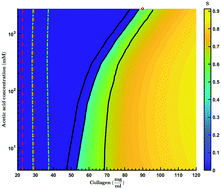Thermodynamic modelling of acidic collagenous solutions: from free energy contributions to phase diagrams†
Abstract
Tropocollagen is considered one of the main precursors in the fabrication of collagen-based biomaterials. Triple helix acidic solutions of collagen I have been shown experimentally to lead to chiral plywood architectures found in bone and “cornea” like tissues. As these plywoods are solid analogues of liquid crystal architectures, bio-inspired processing and fabrication platforms based on liquid crystal physics and thermodynamics will continue to play an essential role. For tissue engineering applications, it has been shown that dilute isotropic collagen solutions need to be flow processed first and then dehydrated. Thus, a complete fundamental understanding of the thermodynamics and free energy contributions in acidic collagen aqueous solutions is necessary to avoid expensive trial-and-error fabrication. To achieve this goal, we analyze the microscopic mechanisms of ordering and interactions in solutions of triple helix collagen, namely mixing, attraction, excluded-volume and chirality. To capture the mentioned physics, we then incorporate and integrate the Flory–Huggins, Maier–Saupe, Onsager and Frank theories. Nonetheless, they together are incapable of providing an acceptable mesophasic description in acidic collagenous solutions because tropocollagen biomacromolecules are positively charged. We then explore a simple and accurate electrostatic mean-field potential. Our results on collagen are in good agreement with experiments and include phase diagrams, phase transition thresholds, and critical isotropic/cholesteric order parameters. The present extended theory is shown to properly converge to classical liquid crystal models and is used to express the phenomenological Landau–de Gennes parameters with more fundamental quantities. This study provides a platform to derive accurate process models for the fabrication of collagen-based materials, considering and benefitting from the full range of underlying interactions.



 Please wait while we load your content...
Please wait while we load your content...